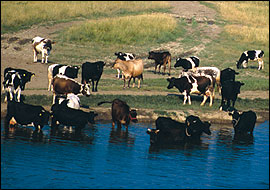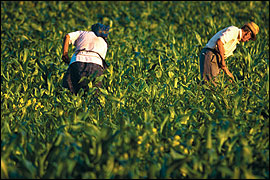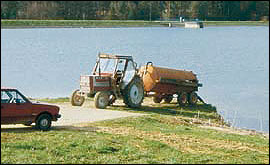 |
Farmers are friends, not foesFarmers do hundreds of jobs most of us would rather avoid. Some of us even call farmers enemies of the environment - from animal killers to soil spoilers. In the Danube River Basin, farming was recently charged as a main water polluter. |
 |
Agriculture is the
biggest source of
nitrogen in the Danube
River Basin, due to
over-use of fertilisers or
from over-production
and poor handling of
solid manure and waste
from raising livestock. |
Toxic growth.
Dozens of toxic chemicals are released into the waters of the Danube River
Basin (DRB) with serious threats to the environment, states the ICPDR's
"Danube River Basin Analysis 2004", the first ever comprehensive
analys is of the Danube environment and pressures impacting it. Many come
from agriculture.
"Farmers need agro-chemicals, such as pesticides and fertilisers, to
sustain yields and produce good quality crops," says Dirk Ahner, Deputy
Director General for the EC's Directorate General for Agriculture and Rural
Development. "Yet, the excessive or inappropriate use of these substances
can contribute to water pollution through the leaching or run-off of nutrients
and pesticides, and through the emission of contaminants from agricultural
by-products and waste."
Pesticides in DRB waters generally increase downstream.
"Alarming concentrations" can be found in
the lower Danube and in some tributaries, says the
Danube Analysis report. The DRB includes 29 of
the EU's list of 33 "hazardous priority substances".
Eleven are agricultural pesticides. Many are used in
producing cereals, rapeseed, sunflower, maize, orchard
fruits and grapes. Only three are authorised in all
countries while a shocking seven are not authorised in
any country, many having been left in old stockpiles,
some in flood-prone areas. A big concern is from DDT,
a pesticide banned in Europe - in Danube samples
taken, 71% exceeded permissible levels.
Non-nutritious nutrients.
Few are aware of nutrient
pollution from agriculture - for example, from nitrogen. One main source
is the poor or over-use of nitrogen fertilisers for crops. Many farmers
apply them at the wrong time of year or in the wrong areas. Some don't consider
the crops being fertilised - after a certain amount, further benefits from
fertilisers stop and even reverse.
Another source of pollution is the over-production and poor handling of
solid manure and liquid waste from raising livestock. Manure can be a good
natural fertiliser for crops, depending on the area of cropland available.
So, on many farms, nearly half of all livestock waste becomes pollution.
Some farmers try to store it properly. Others pile it on the grass or dump
it into streams.
The result is that, for decades, too much nitrogen has been getting into
DRB waters. Mixed with large nutrient inputs from untreated municipal (human)
and industrial waste, this caused nitrogen loads to double from the 1950s
to mid-1980s. Nitrogen levels are still too high. Agriculture is now the
biggest source of nitrogen in the DRB with a 39% share. It's in second place
for phosphorus emissions with a 32% share.
The biggest impact from nutrient pollution is "eutrophication"
which reduces oxygen in the water, decreases plant and animal species and
worsens water quality. Danube nutrient pollution has helped create a severe
ecological imbalance in the Black Sea. Nutrients, notes the World Watch
Institute, have become one of the world's biggest pollution problems.
 |
Farming intensity on the rise.
In the former communist countries, extensive farming - using more land area,
less fertilisers and pesticides - was preserved in many areas, especially
in remote hills and mountains such as Romania's Carpathians. Small farms
survived through strong local demand, limited foreign competition and state
support.
That situation has drastically changed. The end of communism brought major
reductions in state support and access to markets. Free trade meant competition
with powerful western agro-companies and their cheaper products. Many large
state-owned and smaller family farms closed while cities and other types
of work lured young farmers away. On the other hand, one positive result
was a big drop in nutrient pollution and fertiliser use in the DRB, while
pesticide use declined by 40%.
Smaller eastern farmers new to the EU hoped that EU accession would improve
their lot. But a recent reform process of the EU's Common Agricultural Policy
(CAP) is intent on reducing subsidies for farming. This could mean that,
without enough subsidies from either the state or the CAP, eastern production
methods won't be able to compete with larger companies - especially those
now buying up large tracts of nearby lands given lower costs and taxes.
If that happens, intensive farming and pollution into DRB waters could rise
again.
Meeting the law.
One of the best tools to ensure Danube waters stay clean is the EU's Water
Framework Directive (WFD). EU countries are obliged by law to meet WFD objectives
including achieving "good environmental status in all water bodies"
by 2015. It also requires the complete phase-out of all 33 hazardous substances
within 20 years.
An early milestone was each country's assessment of the water bodies within
their boundaries, including whether they risked failing to meet the WFD.
This was done for four "risk categories" including hazardous substances
and nutrients. Some river basins, often crossing many countries, also did
this - hence the success of the Danube River Basin Analysis.
The assessments show that many water bodies across
the EU may not meet WFD objectives and that one of
the main reasons is pollution from farming, especially
from nitrogen and phosphorus. Results from the
Danube Analysis specifically don't fare much better.
In total, percentages of the entire DRB "at risk" or
"possibly at risk" are 55% from nutrient pollution and
73% from hazardous substances. The Danube Delta is
"at risk" from hazardous substances and nutrient pollution.
All Black Sea coastal waters are "at risk" from
nutrient pollution and "possibly at risk" from hazardous
substances. And agriculture is a main cause.
Danube countries now need to develop a "Danube River
Basin Management Plan" by 2009 on how to meet
the WFD by 2015. This will include actions to reduce
the impacts from agriculture.
 |
Some farmers, desperate
for quick-fix answers in
this depressed region,
hope technology is the
key to future posterity.
"Farmers use everything
here including banned
substances," says
Dragana Draskovic NGO
"Europska Dom". |
A less intense CAP.
Sustainable agriculture with less intensive practices is needed for the
entire DRB with reductions in fertilisers, pesticides and nutrients, says
the Danube Analysis report. "Measures could include the extensification
of production, conversion to organic cropping or changes in land use,"
says Stavros Dimas, the EC's Commissioner for the Environment.
"The CAP of today is very different from what it was 15 years ago,"
says Ahner. "The integration of environmental concerns into agricultural
policy has been one of the main priorities in the last decade of reforms
of the CAP." The 2003-04 reforms and the new Rural Development Regulation
are the latest steps.
Reform of the CAP's "first pillar" should help decouple income
support from production and "is expected to reduce incentives for intensive
production". Mandatory "cross-compliance" has made granting
of payments to farmers conditional on their respecting environmental laws
including the EU's Nitrates and Groundwater directives - the WFD is not
yet linked, but may be in the future.
Reform of the CAP's second pillar, rural development programmes, made implementation
of the WFD one of three environmental priorities for rural development for
2007-13. The "meeting standards" measure provides farmers with
temporary support for compliance with demanding new standards such as the
WFD. And new training measures should make farmers more aware of less polluting
techniques.
Interestingly, rural development "agri-environmental schemes"
now support farmers working beyond conventional farming practices such as
raising crops and animals to "farming services" naturally provided
by the environment. This could mean switching land-use from growing crops
to increasing water retention and flood control on their lands.
Changing behaviour in the field.
Many farmers aren't aware of the environmental problems they cause; let
alone how to solve them. Many turn to local farming associations or even
"agricultural pharmacies" for guidance but these often advise
conventional methods.
The Danube Regional Project (DRP) recently launched
a $600,000 project to help DRB farmers reduce
pollution by encouraging the use of "best agricultural
practices" (BAP). Examples of BAP include reducing
over-fertilisation and improving manure storage.
A demonstration project in Vojvodina, Serbia and
Montenegro will develop practical farm management
techniques and guidelines
for training workshops
across the lower
Danube. It will assess
inventories of agricultural
fertilisers and
chemicals currently
used in the DRB.
Finally, it will make
recommendations to
Danube governments
on how to modify national policies and laws to reduce
pollution from farming, for example through improved
links between the WFD and CAP.
 |
Intensive farming - high
numbers for pesticides,
fertilisers, animal density
and equipment - has
well-suited large western
agro-companies intent
on big profits, while
extensive farming uses
more human labour, time
and environmentally
friendly techniques. |
Reform and realities.
The CAP exists primarily to assist farmers and agriculture. "When looking
for the final combination of measures, a balance will need to be struck
between objectives as diverse as water protection, safeguarding and enhancing
other environmental resources and the landscape, maintaining and improving
the competitiveness of our agriculture, and creating new opportunities for
growth and jobs in rural areas," says Ahner.
Dimas adds that the EC must be "sufficiently flexible to take account
of any socio-economic problems caused in trying to meet" environmental
directives. EU countries can get exemptions, such as extension of deadlines
beyond 2015, if they can show major negative impacts to their agricultural
sector. "We need to find win-win solutions that have benefi ts for
farmers and the environment alike."
Friends not foes.
As the second millennium closed, the question was farming "or"
environment in Europe. Many now realise that neither will function properly
without mutual respect and understanding. Farming is being re-defined in
Europe with the opportunity that farmers can be true friends of nature through
providing us with healthy food or environmental services such as protecting
us from floods or purifying our drinking water. But only if they benefit
themselves.
The Danube River Basin map from the Roof Report shows the land use in the
region.
Click here to see the map (PDF-File).